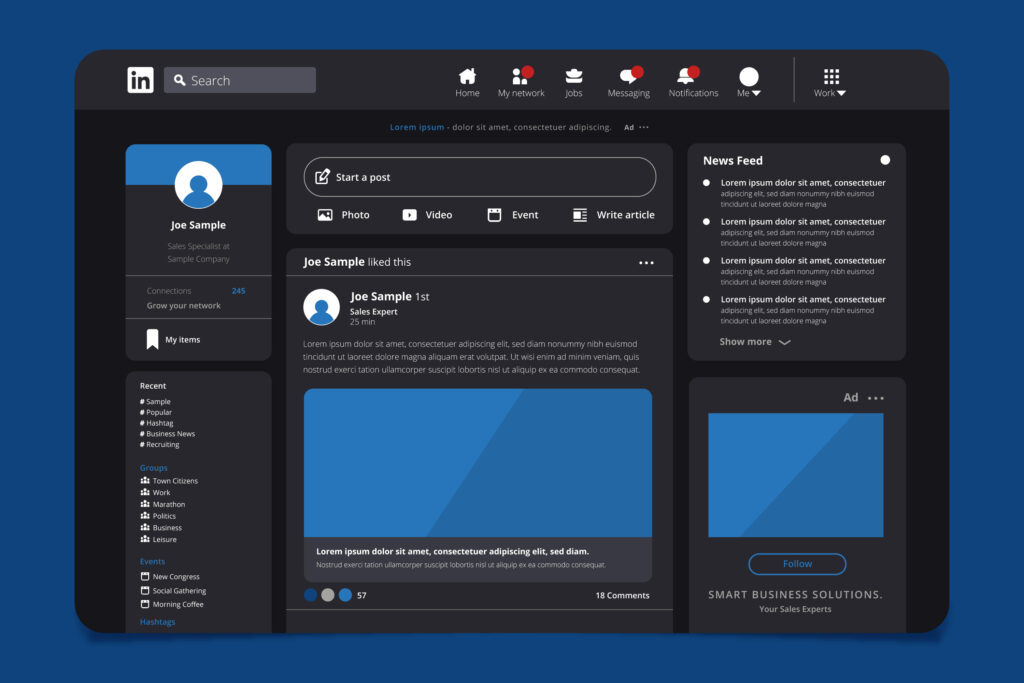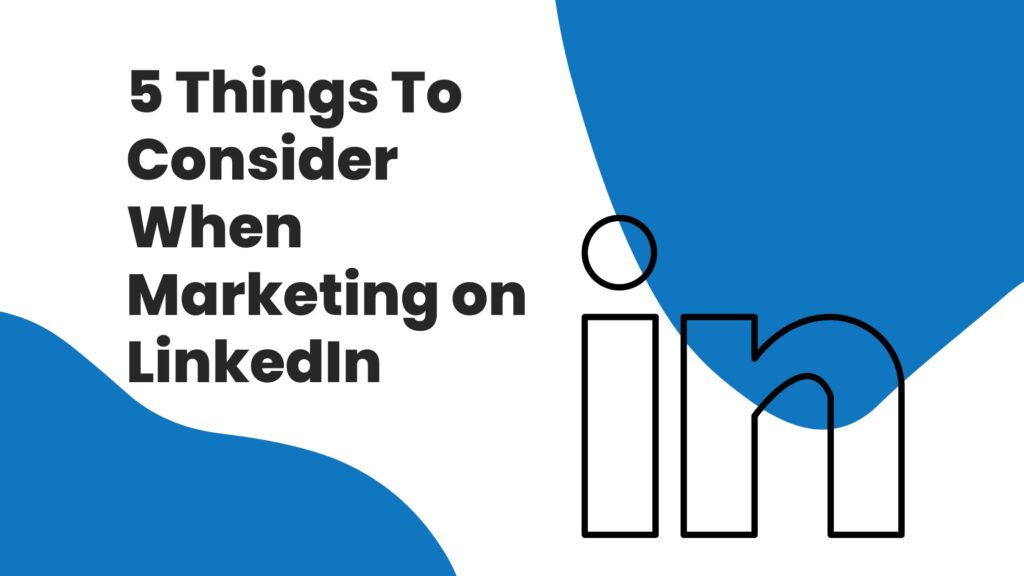Marketing on LinkedIn: 5 things to consider when.
LinkedIn has become an essential platform for businesses looking to connect with professionals, expand their network, and generate leads. However, like any marketing strategy on any other platform, success on LinkedIn requires careful planning and execution. In this blog post, we’ll be exploring five essential things to consider when marketing on LinkedIn, including setting goals, audience targeting, content strategy, building relationships, and measuring and optimising your efforts. By following these guidelines, you’ll be able to make the most of LinkedIn’s powerful features and reach your target audience with compelling content and meaningful connections. So let’s dive in and discover the five key elements of a successful LinkedIn marketing strategy!
Setting Goals: When setting goals for LinkedIn, it’s important to use the SMART framework. SMART stands for Specific, Measurable, Achievable, Relevant, and Time-bound.
Audience targeting: Understand your target audience and tailor your content and advertising to their specific needs, interests, and pain points. LinkedIn provides advanced targeting options such as job title, industry, company size, location, and more.
Content strategy: Create a content strategy that aligns with your goals and resonates with your target audience. Share a mix of original and curated content that is relevant, valuable, and interesting to your audience.
Building relationships: LinkedIn is a professional networking platform, so building relationships is crucial. Engage with your audience by responding to comments, messages and connect with people in your industry.
Measuring and Optimising: Regularly measure and analyze the performance of your LinkedIn marketing efforts using metrics such as engagement rate, click-through rate, and conversion rate. Use this data to optimise your strategy and improve your results over time.
It’s worth to remember that this platform is where B2B and professional networking is the main focus, so adjust your approach accordingly and make sure you understand the audience and how they use the platform when marketing on LinkedIn.

Setting Goals for LinkedIn:
When setting goals for your marketing on LinkedIn, it’s important to start by thinking about what you want to achieve through the platform. Here are some steps you can take to set effective goals:
- Identify your target audience: Understand who you want to reach on LinkedIn, including demographics, job titles, and industries.
- Define your objectives: What do you want to achieve on LinkedIn? Common goals include increasing brand awareness, generating leads, and building relationships with potential customers and partners.
- Determine key performance indicators (KPIs): Identify metrics that will help you measure your progress towards achieving your goals. For example, if your goal is to increase brand awareness, your KPI could be the number of followers on your company page.
- Set specific, measurable, attainable, relevant, and time-bound (SMART) goals: Use the SMART framework to set goals that are specific, measurable, attainable, relevant, and have a specific time frame.
- Specific: Clearly define what you want to achieve, who is involved and what are the required resources to achieve it.
- Measurable: Identify metrics that will help you track your progress and measure your success.
- Achievable: Ensure that your goals are realistic and achievable with the resources you have.
- Relevant: Make sure that your goals align with your overall business objectives and that they are relevant to your target audience.
- Time-bound: Set a specific deadline for achieving your goals, this will help you stay on track and track your progress.
Remember to regularly review your progress and adjust your goals and strategy as needed. Once you have set your goals and KPIs, you can use them as a guide to develop your LinkedIn marketing strategy, create content and campaigns, measure your results and adjust as needed.
An example of SMART goal could be: “By end of Q2 2023, increase the company LinkedIn followers by 50% by publishing 2 pieces of original content every week and boosting 1 post per month targeting specific demographics and job titles.”
Audience targeting for LinkedIn
Audience targeting is an important aspect of any LinkedIn marketing strategy, as it allows you to reach the right people with the right message at the right time. Here are a few key things to consider when targeting your audience on LinkedIn:
- Demographics: LinkedIn provides a wealth of demographic information about its users, such as their job title, industry, company size, location, and more. Use this information to segment your audience and create targeted campaigns that are relevant to their specific needs and interests.
- Job Title: It’s crucial to define the job titles of your target audience as it gives you an idea of the level of decision-making power they have, their responsibilities and the pain points they may have.
- Company Size: The size of the company can give you an idea of the potential budget and the number of people who may be interested in your product or service.
- Industry: Consider the industry that the company belongs to, it can help you understand the challenges and the type of content that may be relevant to your audience.
- Location: Based on where your target audience is located you can focus on events, news and even timezones that can help your content to be more relevant to them.
- Interests: It’s important to consider your audience’s interests when creating content and campaigns. LinkedIn allows you to target people based on the groups they are part of or keywords they used in their profile.
By using LinkedIn’s targeting options, you can reach the right people with the right message at the right time, which can help increase the chances of your campaigns being successful.

Content Strategy for LinkedIn
A content strategy is a plan for creating and distributing content that aligns with your business objectives and resonates with your target audience. Here are a few key things to consider when developing a content strategy for LinkedIn:
- Audience: Understand your target audience and create content that is relevant, valuable, and interesting to them. Consider their needs, pain points, and what type of content they are likely to engage with.
- Goals: Align your content strategy with your overall business goals, such as increasing brand awareness, generating leads, and building relationships with potential customers and partners.
- Format: LinkedIn offers a variety of content formats, such as text posts, articles, videos, images, and presentations. Consider which formats will work best for your audience and goals.
- Frequency: Decide how often you will publish new content. Regularly posting new content can help keep your audience engaged and increase your chances of being discovered by new followers.
- Measurement: Use analytics to measure the performance of your content and use the data to optimize your strategy and improve results over time.
- Repurpose: Leverage your existing content by repurposing it and adapting it to different formats or platforms.
- Collaboration: Collaborate with other professionals in your industry, this will help increase your reach, add variety to your content and position your brand as a thought leader.
It’s important to remember that a content strategy is not a one-time thing, it should be regularly reviewed and adjusted based on the audience engagement, performance and your goals. Also, it’s important to mix up your content and not only focus on promoting your products or services.
Building relationships across LinkedIn
Building relationships is an important part of any LinkedIn marketing strategy, as it allows you to connect with potential customers, clients, and industry professionals. Here are a few ways you can build relationships on LinkedIn:
- Networking: Connect with people in your industry, including potential customers, clients, and influencers. Reach out to them with personalized messages and start building a relationship by engaging in conversations, sharing content and joining groups.
- Engage with your audience: Respond to comments, messages, and mentions. Engage with your audience by asking questions, starting discussions, and encouraging feedback.
- Use LinkedIn groups: Join groups that are relevant to your industry and participate in discussions, answer questions and share valuable content.
- Publish thought leadership content: Share valuable content that showcases your expertise in your industry. This can help position your brand as a thought leader and increase your credibility.
- Collaboration: Collaborate with other professionals in your industry, such as guest blogging, hosting webinars, or co-authoring research. This helps increase your reach and add variety to your content.
- Humanise your brand: Share content that shows the people behind your brand and what makes them unique. This helps to build trust and increase engagement with your audience.
It’s worth to remember that building relationships takes time, effort and consistency, and as with all social media platforms, it’s important to keep authenticity and not to be overly salesy.
Measuring and Optimising your LinkedIn
Measuring and optimising your LinkedIn marketing efforts is crucial to determining what’s working and what’s not, and making data-driven decisions to improve your results over time. Here are a few key things to consider when measuring and optimizing your LinkedIn marketing efforts:
- Identify key performance indicators (KPIs): Identify metrics that will help you measure your progress towards achieving your goals. These may include engagement rate, click-through rate, conversion rate, and lead generation.
- Use LinkedIn analytics: LinkedIn provides built-in analytics tools to track the performance of your company page, content, and advertising. Use this data to gain insights into how your audience is engaging with your content and how your campaigns are performing.
- Use tracking and conversion pixels: Implement tracking and conversion pixels to track the performance of your ads and measure the ROI of your campaigns.
- Test, Test, Test: Continuously test different elements of your strategy like headlines, images, audience targeting, ad formats, and messaging to see what works best for your audience.
- A/B testing: Use A/B testing to compare the performance of different variations of your content and advertising.
- Iterate: Based on the results, adjust your strategy and optimize your content and campaigns accordingly.
By regularly measuring and optimising your LinkedIn marketing efforts, you can ensure that you are getting the best results possible and making data-driven decisions to improve your performance over time.

A linkedin Marketing Strategy
A LinkedIn marketing strategy typically involves using the LinkedIn platform to connect with and engage with potential customers, clients, and industry professionals. This can include creating a company page, publishing content on the platform, networking with other professionals, and using paid advertising to reach a wider audience. The goal of a LinkedIn marketing strategy is typically to increase brand awareness, generate leads, and build relationships with potential customers and partners.

